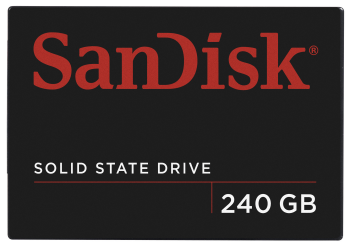SanDisk sent out a press release today, announcing its G3 Series of solid-state drives (SSDs). These MLC-based SSDs are available in 60, 120 and 240GB capacities and are capable of 200MB/s read and 140MB/s write speeds.

SanDisk Corporation (NASDAQ: SNDK) today unveiled its third-generation family of solid-state drives (SSDs). Using multi-level cell (MLC) NAND flash memory technology, SanDisk’s G3 Series establishes new benchmarks in performance and price-performance leadership in the SSD industry.
Designed as drop-in replacements for hard-disk drives (HDDs) in notebook PCs, the initial members in the SanDisk G3 family are SSD C25-G3 and SSD C18-G3 in the standard 2.5” and 1.8” form factors respectively, each available with a SATA-II interface. Available in capacities of 60, 120 and 240GB*, the unit MSRPs are $149, $249 and $499, respectively.
The G3 SSDs are more than five times faster than the fastest 7,200 RPM HDDs and more than twice as fast as SSDs shipping in 2008, clocking in at 40,000 vRPM and anticipated sequential performance of 200MB/s read and 140MB/s write. The G3 SSDs provide a Longterm Data Endurance (LDE) of 160 terabytes written (TBW) for the 240GB version, sufficient for over 100 years of typical user usage.
“SanDisk’s G3 SSD has met the demand of a 120GB SSD at less than $250 with an exceptional user experience” said Rich Heye, sr. vp and general manager, Solid State Drives (SSD) business unit, SanDisk. “Three key features developed by SanDisk enable this new design: a new SSD algorithm called ExtremeFFSTM allows random write performance to potentially improve by as much as 100 times over conventional algorithms; reliable 43nm multi-level cell (MLC) all bit-line (ABL) NAND flash; and SanDisk’s new SSD controller, which ties together the NAND and the algorithm.”
“With large capacities and aggressive pricing, SSDs are poised to enter mainstream corporate notebooks in 2009.” Heye explained, “Given the current economic environment, corporate IT managers have also described a desire to extend the service life of existing notebooks. These notebooks are already maxed out on DRAM, and struggle to meet users’ performance expectations. These existing WinXP notebooks can be upgraded to a 60GB SSD for $149, resulting in a system that frequently outperforms a new notebook with a HDD, thereby delaying the need for large capital purchases.”
“Web-Feet Research has tested the replacement of the HDDs in three year old Notebooks with SSDs and has found an improvement in boot times, application loading and general user responsiveness that, in many cases, exceeds what a new notebook with an HDD can deliver,” said Alan Niebel, Principal at Web-feet Research. “In these challenging economic times, IT managers are looking for ways to reduce IT spending without adversely affecting their user base and the SanDisk G3 SSD solution extends the notebook replacement cycle an additional two years at minimal cost.”
The SanDisk G3 SSDs will be available to this market in mid 2009, in a 2.5” PATA configuration expressly for this purpose. In addition, the SanDisk G3 SSDs will be available on sandisk.com for do-it-yourself (DIY) enthusiasts.